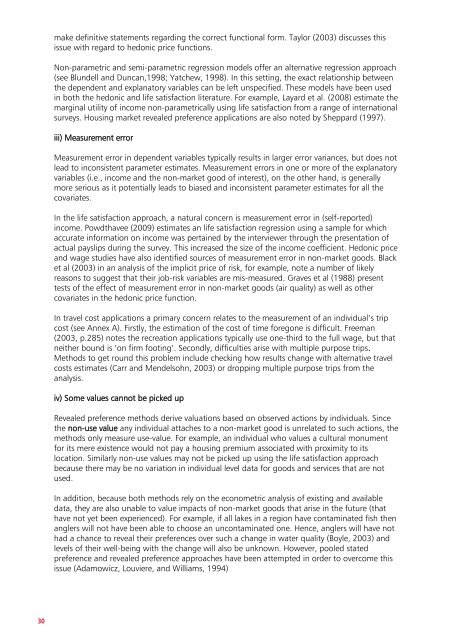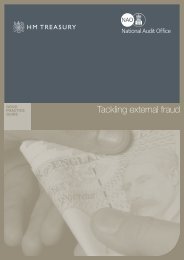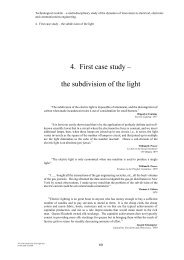Valuation Techniques for Social Cost-Benefit Analysis: - HM Treasury
Valuation Techniques for Social Cost-Benefit Analysis: - HM Treasury
Valuation Techniques for Social Cost-Benefit Analysis: - HM Treasury
You also want an ePaper? Increase the reach of your titles
YUMPU automatically turns print PDFs into web optimized ePapers that Google loves.
30<br />
make definitive statements regarding the correct functional <strong>for</strong>m. Taylor (2003) discusses this<br />
issue with regard to hedonic price functions.<br />
Non-parametric and semi-parametric regression models offer an alternative regression approach<br />
(see Blundell and Duncan,1998; Yatchew, 1998). In this setting, the exact relationship between<br />
the dependent and explanatory variables can be left unspecified. These models have been used<br />
in both the hedonic and life satisfaction literature. For example, Layard et al. (2008) estimate the<br />
marginal utility of income non-parametrically using life satisfaction from a range of international<br />
surveys. Housing market revealed preference applications are also noted by Sheppard (1997).<br />
iii) Measurement error<br />
Measurement error in dependent variables typically results in larger error variances, but does not<br />
lead to inconsistent parameter estimates. Measurement errors in one or more of the explanatory<br />
variables (i.e., income and the non-market good of interest), on the other hand, is generally<br />
more serious as it potentially leads to biased and inconsistent parameter estimates <strong>for</strong> all the<br />
covariates.<br />
In the life satisfaction approach, a natural concern is measurement error in (self-reported)<br />
income. Powdthavee (2009) estimates an life satisfaction regression using a sample <strong>for</strong> which<br />
accurate in<strong>for</strong>mation on income was pertained by the interviewer through the presentation of<br />
actual payslips during the survey. This increased the size of the income coefficient. Hedonic price<br />
and wage studies have also identified sources of measurement error in non-market goods. Black<br />
et al (2003) in an analysis of the implicit price of risk, <strong>for</strong> example, note a number of likely<br />
reasons to suggest that their job-risk variables are mis-measured. Graves et al (1988) present<br />
tests of the effect of measurement error in non-market goods (air quality) as well as other<br />
covariates in the hedonic price function.<br />
In travel cost applications a primary concern relates to the measurement of an individual‘s trip<br />
cost (see Annex A). Firstly, the estimation of the cost of time <strong>for</strong>egone is difficult. Freeman<br />
(2003, p.285) notes the recreation applications typically use one-third to the full wage, but that<br />
neither bound is ‗on firm footing‘. Secondly, difficulties arise with multiple purpose trips.<br />
Methods to get round this problem include checking how results change with alternative travel<br />
costs estimates (Carr and Mendelsohn, 2003) or dropping multiple purpose trips from the<br />
analysis.<br />
iv) Some values cannot be picked up<br />
Revealed preference methods derive valuations based on observed actions by individuals. Since<br />
the non-use value any individual attaches to a non-market good is unrelated to such actions, the<br />
methods only measure use-value. For example, an individual who values a cultural monument<br />
<strong>for</strong> its mere existence would not pay a housing premium associated with proximity to its<br />
location. Similarly non-use values may not be picked up using the life satisfaction approach<br />
because there may be no variation in individual level data <strong>for</strong> goods and services that are not<br />
used.<br />
In addition, because both methods rely on the econometric analysis of existing and available<br />
data, they are also unable to value impacts of non-market goods that arise in the future (that<br />
have not yet been experienced). For example, if all lakes in a region have contaminated fish then<br />
anglers will not have been able to choose an uncontaminated one. Hence, anglers will have not<br />
had a chance to reveal their preferences over such a change in water quality (Boyle, 2003) and<br />
levels of their well-being with the change will also be unknown. However, pooled stated<br />
preference and revealed preference approaches have been attempted in order to overcome this<br />
issue (Adamowicz, Louviere, and Williams, 1994)





![AIRTO [Professor Dr Brian Blunden] - HM Treasury](https://img.yumpu.com/15492848/1/184x260/airto-professor-dr-brian-blunden-hm-treasury.jpg?quality=85)










